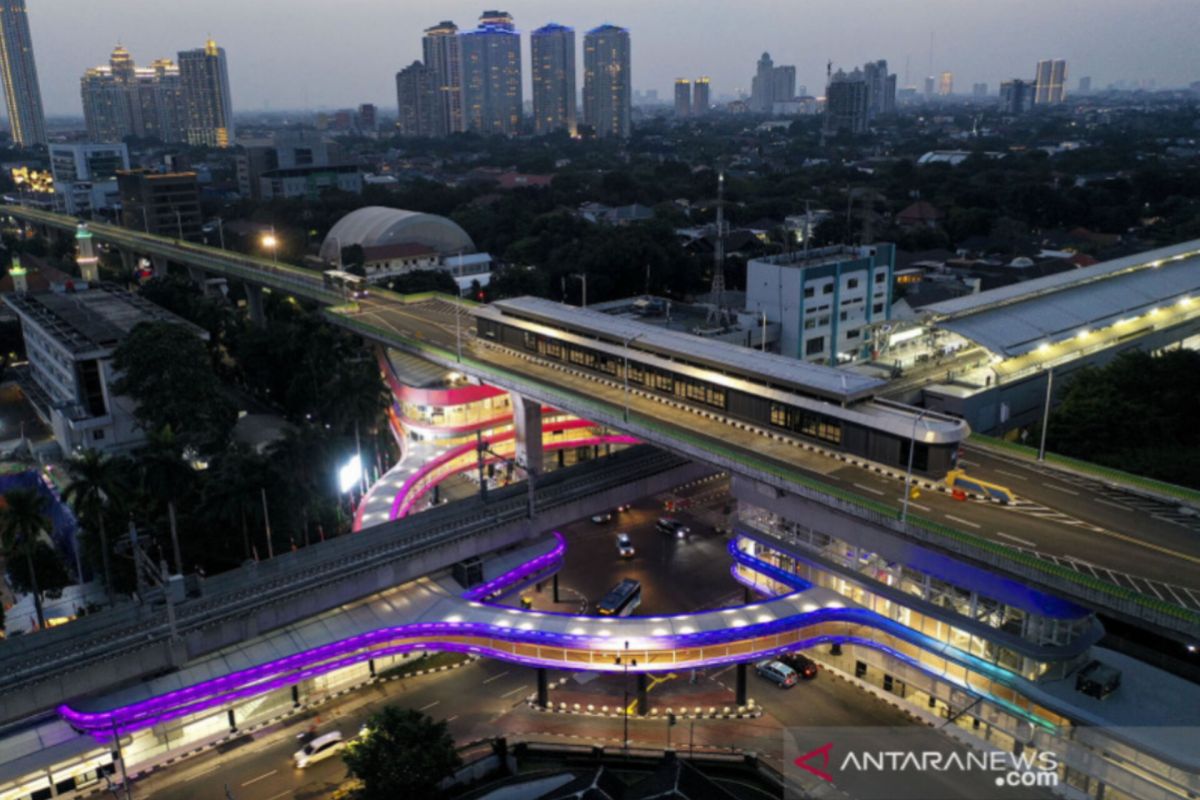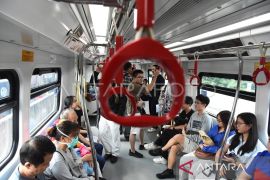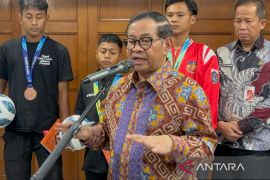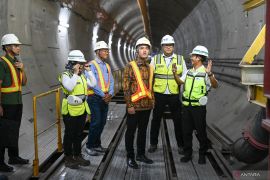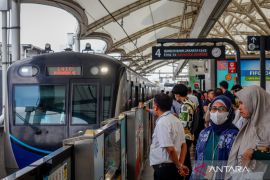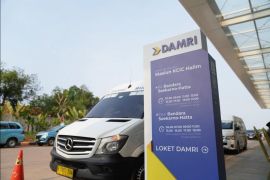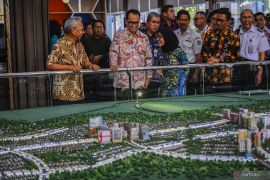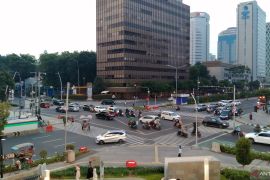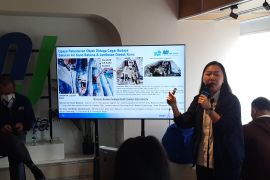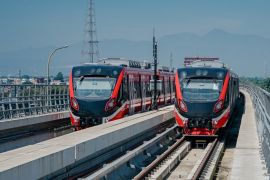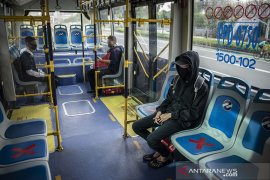The newly inaugurated LRT complements Jakarta’s other public transportation systems, such as the Commuter Line (KRL), TransJakarta, MRT, and the Jakarta-Bandung Fast Train (KCJB).
Apart from these public transportation facilities, there are also other means of public transportation provided by private companies, such as taxis and online transportation services, that can be easily accessed in the city.
The large number of public transportation systems in Jakarta indicates the several options available for residents to travel within the city and its surrounding area.
Data from the Jakarta Transportation Service and Statistics Indonesia (BPS) recorded that there are 19.63 million public transport movements in Jakarta every day.
Of this number of movements, the use of online motorcycle taxis reached 1,003,160 trips per day, followed by KRL, with 781,745 trips per day; TransJakarta, 747,920 trips per day; MRT, with 115,135 trips per day; and LRT, 5,640 trips per day.
However, the modal share of public transportation from the total movement in Jakarta is only 18.45 percent with online transportation, or 10.29 percent without including online transportation.
This shows that the use of public transportation in Jakarta is still low. Hence, efforts and policies to increase the modal share of public transportation are of utmost importance, including by encouraging integration between means of public transportation.
Presidential mandate
Transportation integration in Jakarta has become part of the government's big development plan, as the regional transportation system, as part of the national transportation system, has a very strategic position.
Hence, President Joko Widodo (Jokowi) urged stakeholders to realize the integration of transportation modes in Jakarta-Bogor-Depok-Tangerang-Bekasi (Jabodetabek).
He also pressed for infrastructure development that connects two modes of transportation, such as integration between the Halim LRT station and the Halim KCJB station or between the KRL station and the TransJakarta bus stop, to be feasible.
Furthermore, an integrated public transport payment system in all transportation modes should also be developed. Moreover, collaboration with transportation providers should be strengthened.
“It would be better if once we enter the destination, the system already planned the trip with what transportation should we take,” the president remarked.
The plan to develop the Jabodebek LRT to Bogor City and the Jakarta LRT to Manggarai needs further study, considering the high level of public interest in these means of transportation. Public transportation must also be friendly to elderly passengers, people with disabilities, and children and pregnant women.
The mandate to realize transportation integration in Jakarta is also contained in Presidential Regulation Number 55 of 2018 concerning the Jabodetabek Transportation Master Plan for 2018-2029.
The master plan sets several targets for developing public transportation in the Jabodetabek area, including the movement of people using urban public transportation must reach 60 percent of the total people movement and the coverage of urban public transportation services reaching 80 percent of the total length of roads.
The master plan also includes strategies to integrate the construction and development of infrastructure network systems and transportation services, integrate urban transportation development in the Jabodetabek area, and integrate transportation operations and transportation financing schemes.
Defining factor
"Even though it is not a simple process, the integration of public transportation has great benefits, such as increasing accessibility and comfort for users," public transportation activist and initiator of the Jakarta Transportation Discussion Forum (FDTJ), Adriansyah Yasin, remarked.
Transportation integration has been realized at the South Jakarta CSW bus stop that connects TransJakarta with the MRT. Meanwhile, in terms of the fare, the JakLingko system has also helped the public to access public transportation.
With a developed transportation infrastructure, people can be interested in shifting to public transportation, along with a disincentive of using private vehicles, with increased parking fees and implementation of electronic road pricing (ERP).
However, this regulation should be accompanied by the provision of proper public transportation as an alternative for those affected.
Regional governments in Jakarta's buffer areas must also develop mass public transportation services that complement existing mass transportation modes in their areas.
The Bogor, Depok, Tangerang, and Bekasi governments must begin to expedite their development with Jakarta to improve intercity transportation integration.
Executive Director of the Transportation Study Institute (Instran), Deddy Herlambang, highlighted that strengthening the authority of the Jakarta Transportation Management Agency (BPJT) can spur the integration of public transportation in Jabodetabek.
The government can learn from Singapore's Land Transport Authority (LTA), as an effort to strengthen BPJT's authority and accelerate transportation integration in Jabodetabek.
So far, the BPJT’s authority is only responsible for regulating and not directly operating public transportation. Implementation of the Jabodetabek Transportation Master Plan has been carried out by the transportation service in each region.
Hence, BPJT’s participation can be strengthened by improving the agency's authority to make efforts as stated in the master plan in accordance with Presidential Decree No. 55 of 2018.
Sectoral egos between state-owned enterprises (SOEs), regional enterprises (BUMD), and public transportation operators should be avoided to advance public transportation integration in Jabodetabek. This is especially important since the integration referred to is limited to operational integration and not institutional integration.
By strengthening the integration of public transportation in the capital city, the government is also providing proper and accessible public transportation to the people.
Accessible public transportation will encourage people to use it. Thus, the target of 60 percent of people's movements by public transport based on Presidential Decree No. 55 of 2018 will be achieved on time.
Moreover, advancing the integration of public transportation will support efforts to strengthen Jakarta's status as a national economic center after the capital city’s relocation to the new capital city (IKN) Nusantara in East Kalimantan in the near future.
Related news: Jakarta-Surabaya high-speed train included in blueprint: Minister
Related news: President Jokowi visits Hub Space transportation exhibition in Jakarta
Related news: President Jokowi presses for integrating public transportation
Translator: Nabil Ihsan, Resinta Sulistiyandari
Editor: Sri Haryati
Copyright © ANTARA 2023
